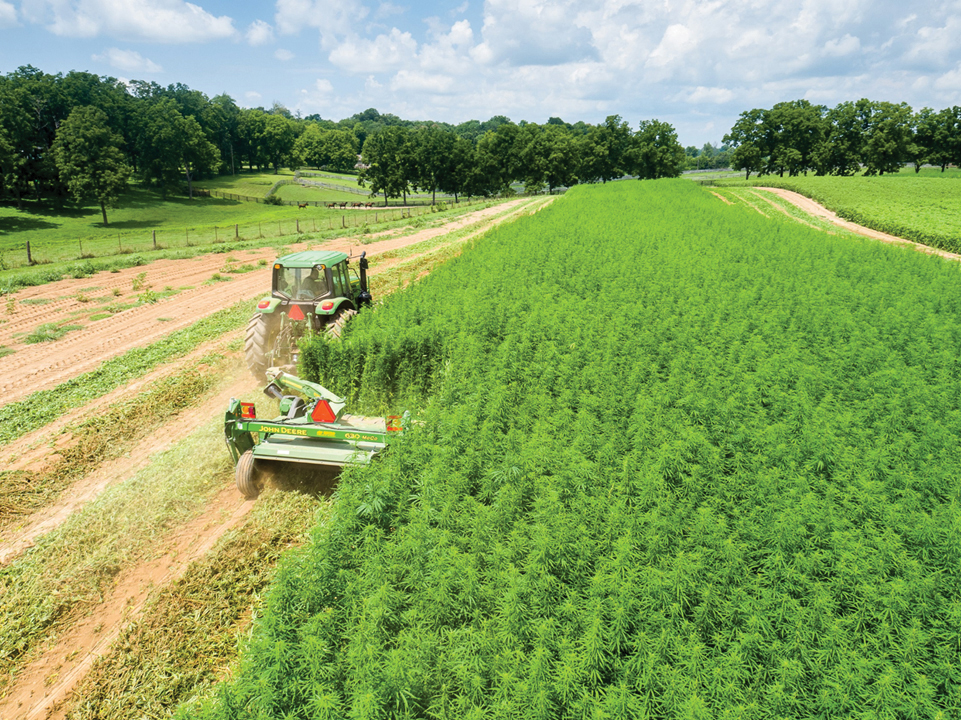Today, 29 U.S. states continue to grapple with legislation surrounding the cultivation of cannabis, while 21 states explore the economic and sustainable benefits of the industry.
Opinions surrounding medical or recreational use of the more daring cannabis flower, marijuana, often eclipse the true economic value of the hemp plant. Plants with less than 0.3% concentration of tetrahydrocannabinol (THC) are classified as hemp.
In 2021, the value of hemp production in the open and under protection for the United States totaled $824 million, with industrial hemp grown in the open valued at $712 million grown across 54,200 acres, according to the USDA. The top 10 states by area harvested were:
| State | Acres |
|---|---|
| Montana | 4,500 |
| Colorado | 3,100 |
| Minnesota | 2,300 |
| California | 2,250 |
| Utah | 2,150 |
| North Carolina | 1,850 |
| Oregon | 1,850 |
| South Dakota | 1,700 |
| Kentucky | 1,500 |
| Missouri | 1,150 |
In recent years hemp has making a comeback. Yes, that’s right, its comeback.
New England colonies introduced the plant to North America with the arrival of the Mayflower. Domestic production of hemp was highly encouraged, so much so that it was a legally required crop from Virginia farmers in the early 1600s.
The crop’s fiber was turned into rope, sails and clothing, while seeds provided grain and oil provided food for both humans and animals. Taxes could be paid with it too, if only in Virginia, Maryland and Pennsylvania.
Synthetic fibers and plastics later supplied a modern solution to aged manufacturing practices for textile products. It was a switch that offered a cheaper, faster solution for businesses and consumers alike, but not necessarily a long lasting, sustainable one.
The cannabis plant fell victim to drug-related issues as a result of the Great Depression. U.S. Congress passage of the 1937 Marijuana Tax Act, which criminalized unauthorized possession of marijuana, largely phased out crop production.
In 2014, the U.S. Farm Bill lightly reintroduced the industry, allowing for state-run higher education and agriculture department research programs focused on hemp cultivation. Four years later, the 2018 Farm Bill gave room for states to produce hemp for more expansive purposes, like commercial use.
Getting The Ball Rolling
Pennsylvania was well down the USDA’s 2021 list of states by hemp harvested, at only 310 acres. Removing the red tape surrounding hemp production has been more difficult to navigate than those like the Pennsylvania Hemp Industry Council’s (PHIC) Chairwoman Erica Stark would like.
 “My short-term goal is to get some commercial scale processing happening here, like full stop. Long term, I want to drive down the highway and want every other crop I see to be hemp instead of corn or soy. I am looking forward to the day it’s no longer novel.”
“My short-term goal is to get some commercial scale processing happening here, like full stop. Long term, I want to drive down the highway and want every other crop I see to be hemp instead of corn or soy. I am looking forward to the day it’s no longer novel.”
— Erica Stark, Chairwoman, Pennsylvania Hemp Industry Council
“It’s taking longer than I or anybody would really like to see happen, but there is a method to this madness. The farmer that is going to grow hemp for industrial purposes, whether that be fiber, grain or both, is a very different type of farmer,” says Stark. “These are row crop farmers that are already growing things like corn or wheat. Hemp would be a natural fit into their rotation. However, they are not going to grow it if they don’t have someone ready to buy it.”
In 2022, through Pennsylvania’s USDA-approved hemp program, the Department of Agriculture issued 275 hemp growing permits, which included 14 research permits. Additionally, there were 53 hemp processing permits and two research permits.
Farmers want to grow it, manufacturers are ready to utilize it, but the state and U.S. lack adequate infrastructure required to process millions of acres of hemp. Private-sector investment into commercial processing facilities remains clouded in the lingering public confusion of cannabinoid hemp and industrial hemp.
Ideally, having hemp decortication facilities (for mechanical separation of certain fibers) within 50 to 75 miles of where the crop is produced is beneficial to the overall manufacturing process. Introducing that infrastructure in these rural communities would not only create a plethora of jobs, but a new, local supply chain.
“We have great farmland, we have great soil and we have great climate conditions for growing hemp. Then you throw in the mix our close proximity to all of the major ports and it really does paint a strong picture of why Pennsylvania is an ideal location for that type of investment,” says Stark.
Money Motivation
Led by Chairwoman Stark, the PHIC covers the state’s Berks, Chester and Lehigh counties. In January 2023, PHIC was selected as one of the three recipients of $200,000 in grant funding by the administration of Governor Josh Shapiro to share the story of the Commonwealth’s hemp industry. (Separately, Shapiro has proposed in his 2023-2024 budget a 20% tax on adult-use recreational marijuana products, even as no new legislation for legalization has yet been filed.)
Of the funding, PHIC received $150,000 for Project Invest in PA Hemp. A statewide partnership between the Urban Affairs Coalition and All Together Now Pennsylvania, Pennsylvania Hemp Now was granted $48,000. Transition Town Media, covering Delaware and Schuylkill counties, was granted $2,000 for Promoting Hemp as a Transitional Product to Next Generation Economy.
At the time of the grant announcement the Administration shared that an additional $392,000 would be awarded in March 2023. In total, the Pennsylvania Farm Bill has provided over $1.12 million in hemp-focused funding, $592,000 just three months into 2023.
“It sends a strong signal that Pennsylvania is open for business. Its invites hemp processors to come here and investors to invest in these facilities right here in Pennsylvania,” says Stark.
In collaboration with Hemp-Alternative, LLC; DON Processing LLC; Americhanvre LLC; Coexist Build LLC; PhilaFabric LLC and Intention Lifestyles, LLC, the funding PHIC received will be used to promote hemp growth.
“We are focusing on hemp for construction materials, grain and food and then also for textiles, and not necessarily just clothing,” Stark says. “A lot of the time when people hear textile they just think of clothing, but textiles include nonwoven products like disinfecting wipes. Those things are typically made of plastic, which was news to me. When products like that are made from hemp it then makes them biodegradable and much more sustainable.”
Through collaborative promotion of industrial hemp, Pennsylvania is focused on providing education on the vast distinctions between industrial hemp and cannabinoid hemp industries for its famers and investors. Its goal is to spread a clear definition of what hemp production and processing entails, separating it from the inevitable comparison to CBD or THC products and thus potentially removing tricky legal barriers.
While the state may be making strides in the right direction to promote the industry itself, Stark says a lack of incentives may be the missing link for companies looking to invest.
“We are hoping to work a bit closer, moving forward in conjunction with this grant and the Shapiro Administration to try and get a more specific economic development stimulus package,” she says, “whether that be tax incentives or expansion of Opportunity Zones, things of that nature, to further appeal to that investor.”

